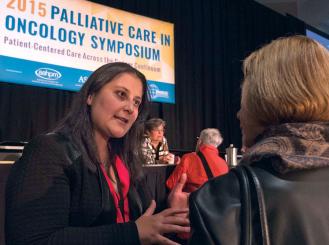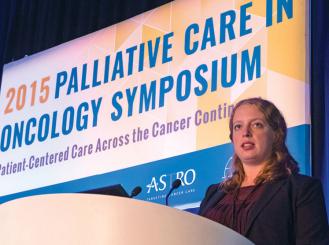Dec 14, 2015
The Palliative Care in Oncology Symposium, held October 9-10 in Boston, MA, brought together more than 670 members of the cancer care community, including oncologists, radiologists, palliative care specialists, nurses, and patient advocates. Sessions delivered information on palliative care communication, access, and integration, and placed special emphasis on the science and treatment of two common and distressing symptoms in patients with cancer: pain and cachexia.
Enhancing Communication
As part of the Welcome and General Session 1, “Improving Communication— Best Practices and Novel Tools,” Areej El-Jawahri, MD (pictured left), presented a study showing that patients who watched a video and had a conversation about CPR were more likely to decline it as a life-prolonging option compared to patients who only had a conversation about CPR and its relative ineffectiveness (81% vs. 58%; p = 0.03; Abstract 7). Eighty-one percent of participants found the video helpful, and 94% felt comfortable watching it and would recommend it to others. Discussant Anthony L. Back, MD, emphasized that the true value of video is not that it takes the place of the clinician– patient interaction, but that it allows physicians to focus on understanding the patient’s needs while letting the video deliver the critical information.
Joanna Paladino, MD, presented a study examining how structured conversations about values, priorities, and goals surrounding end-of-life issues affect patients’ anxiety and depression (Abstract 9). The study found that the patients in the conversation intervention group had significantly lower levels of anxiety and depression compared to the control group and that reductions persisted for 2 months after the conversation.
Jonathan Marron, MD, presented a study showing that sharing a negative prognosis with the parents of a child being treated for cancer did not negatively affect depression or anxiety levels in parents, nor did it prompt loss of hope (Abstract 10). In particular, high quality information and high-quality communication were associated with parents having greater peace of mind, greater trust, and a trend toward less anxiety. However, in the study, accurate knowledge of the child’s prognosis was associated with less hope and a trend toward less peace of mind, and a similar outcome was noted in the overall population, Dr. Marron said. “Although concerning at first blush, [the finding regarding accurate knowledge of a child’s prognosis] is not surprising given the negative prognosis of the child,” Dr. Marron said. “Bad news is difficult to hear, but it matters in how we deliver it. We have to be careful that we don’t let our desire to protect our patients outweigh our responsibility to provide them with an assessment of their outcome.”
Judith B. Vick, BA (pictured right), a student at Johns Hopkins University School of Medicine, presented the preliminary results of an ongoing research project at Dana- Farber examining whether use of the “Surprise Question”—“Would you be surprised if this patient died within the next year?”—could effectively identify patients most at risk of death (Abstract 8). The study provided mixed results, Ms. Vick said. Use of the question was 90% specific and had a 95% negative predictive value; however, it had only a 42% positive predictive value, and was only 59% sensitive for the “no” response.
Symptom Management
Kavita Dharmarajan, MD, MSc, presented a study initiated by Sanders Chang at Icahn School of Medicine at Mount Sinai, investigating the effect of an intervention to encourage adoption of short-course radiation therapy (RT) for symptomatic bone metastases (Abstract 110). After initiation of the intervention, radiation oncologists were more likely to use shorter-duration RT, including an increase in the use of single-fraction and 2- to 5-fraction RT, with a concomitant decrease in the use of courses of more than 5-fraction RT. “Increasing the use of short-course radiation treatments was associated with reduced time spent in the hospital for patients and families,” Dr. Dharmarajan said. “Patients were more likely to finish their treatment and get support from palliative care. Changing practice can lead to improved care for patients and families, and greater efficiency for health systems.”
A study presented by Rudolph M. Navari, MD, PhD, showed that among patients receiving highly emetogenic chemotherapy, use of olanzapine in combination with standard antiemetics improved the control of nausea and emesis compared to patients receiving placebo in combination with aprepitant and dexamethasone during the 24 hours post-chemotherapy (74% vs. 45%, p < 0.0006), 24 to 120 hours post-chemotherapy (43% vs. 26%, p < 0.0006), and the overall period (0 to 120 hours; 39% vs. 22%, p < 0.0006; Abstract 176). Dr. Navari said that aside from transient sedation observed on day 2 post-chemotherapy, no significant adverse effects were noted with the use of olanzapine.
In his presentation on “Neural Mechanisms of Cancer Pain,” Brian L. Schmidt, DDS, MD, PhD, FACS, demonstrated that pain in patients with cancer is caused by a multitude of factors and is far more complex than previously appreciated. Whereas classical thinking about cancer pain is that it is a function of destruction of tissue and nerve invasion, recent research highlights that cancer causes pain through many different mechanisms, and that different cancer types may have separate and distinct biochemical pathways underlying the pain response.
Eduardo Bruera, MD, FAAHPM, provided a comprehensive overview of the evolving understanding of the metabolic influences and implications of cachexia. Importantly, Dr. Bruera noted that classical thinking defining cachexia as necessarily related to nutritional deficits needs to be abandoned in light of research showing that body mass index and weight alone are insufficient for a diagnosis. Instead, several relevant prognostic factors have been identified and are the subject of ongoing research, especially testosterone and CRP level, low albumin levels, and vitamin D deficiency (especially in patients with darker skin tone). Furthermore, cachexia leads not only to a loss of muscle tone, but also of muscle mass and functionality.
International Access Issues
Kathleen M. Foley, MD, discussed efforts by the international community to integrate palliative care into low-resource settings. Although economic barriers are pervasive—and compounded by cultural differences, misunderstandings, and politics—several programs have proven highly effective at bringing about changes. Some initiatives have used strong, even jarring language and imagery to effect change—for example, a campaign in Ukraine emphasized the need to “stop torture in health care” to promote the availability of effective pain relief for seriously ill patients. Dr. Foley said positive change can be achieved by finding ways to work with local health officials and by providing technical support for government and nongovernment programs.


